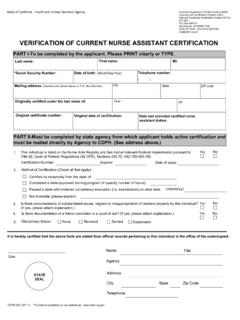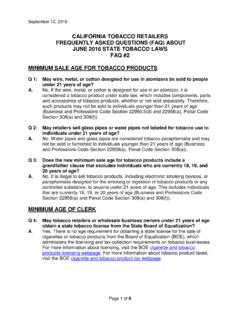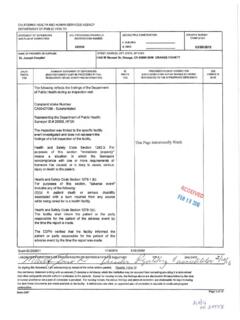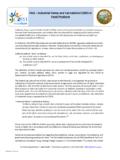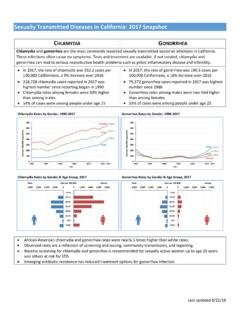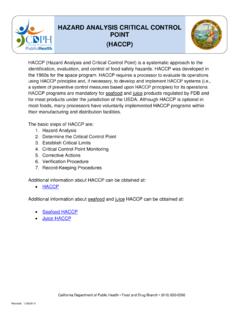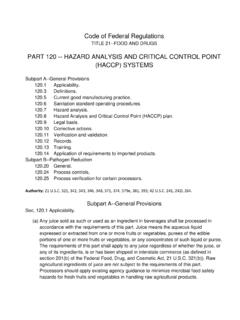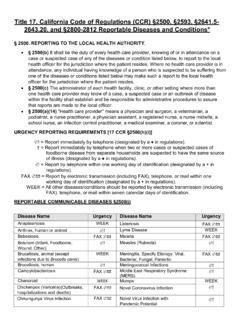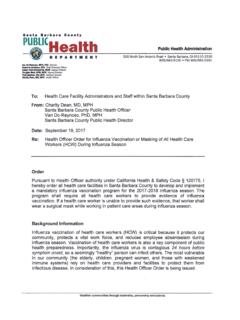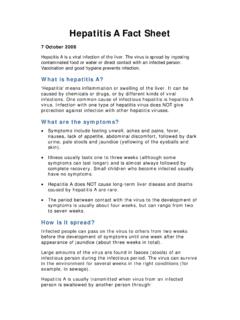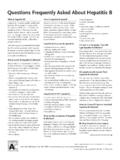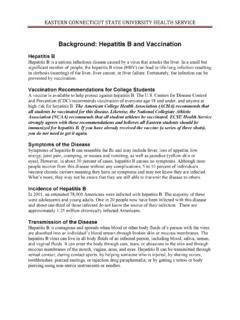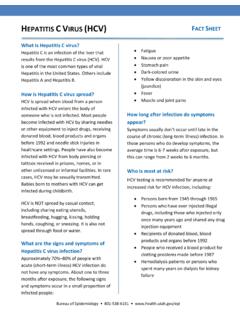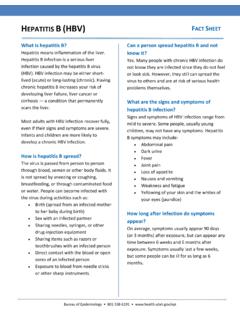Transcription of Foodborne Hepatitis A Fact Sheet - CDPH Home
1 State of California California Department of Public Health Health and Human Services Agency Division of Communicable Disease Control Foodborne Hepatitis A fact Sheet What is Hepatitis A? Hepatitis A is a liver disease caused by the Hepatitis A virus (HAV) which multiplies in the liver and is shed in the feces. Hepatitis A is a vaccine-preventable illness. HAV c an be spread person to person or through contaminated food or beverages. How common is Hepatitis A in California? There are about 200 c as es of Hepatitis A reported each year in California.
2 The number of cases has been steadily declining throughout the United States due to the routine use of Hepatitis A vaccines for children and improved food safety measures and sanitation practic es . How does a person get Hepatitis A? A person can get Hepatitis A by coming into contact with the feces of an HAV-infected person. This can happen when an infected person doesn t wash their hands properly after using the toilet. In the United States, most infections result from close personal contact with an infected household member or a sexual partner.
3 In addition, people c an become infected by consuming food or drinks prepared by an HAV-infected food handler. Many infections are acquired during international travel to countries with poor sanitation, particularly in Africa and parts of Asia. Some foods can be contaminated during growing, harvesting, or processing, and can cause outbreaks if eaten uncooked or raw. Uncooked foods that have caused Hepatitis A outbreaks include frozen berries, green onions, and raw shellfish. What are the signs and symptoms of Hepatitis A?
4 Symptoms of Hepatitis A usually begin 15 to 50 days after a person is infected and range from mild illness lasting 1 to 2 weeks to severe illness lasting months. Signs and symptoms may include: Fever Fatigue Loss of appetite Diarrhea Nausea or vomiting Abdominal pain Yellowing of the skin or eyes Light-colored feces Dark-colored urine Some people with HAV infection do not have any symptoms. This is more common in children. Severe complications are rare, but are more common in older adults and people with liver disease, and may include prolonged or relapsing infections or liver failure.
5 How is Hepatitis A diagnosed? The symptoms of Hepatitis A are similar to other viral Hepatitis infections, so diagnosis requires a blood test. 2 What is the treatment for Hepatitis A? There is no specific treatment for Hepatitis A. Healthcare providers usually recommend rest, good nutrition, and plenty of fluids while the disease runs its course. Most persons with Hepatitis A do not require hospitalization. How can a person reduce their risk of getting Hepatitis A? The simplest way to avoid Hepatitis A is to be vaccinated with the Hepatitis A vaccine.
6 Hepatitis A vaccination is routinely recommended for: All children at age 1 year Travelers to countries that have high rates of Hepatitis A Men who have sexual contact with other men Users of injection and non-injection illegal drugs People with chronic liver diseases such as Hepatitis B or Hepatitis C, or clotting-factor dis orders But anyone not previously vaccinated should consider the Hepatitis A vaccine and discuss this with their healthcare provider. To reduce the risk of exposure to HAV: W ash hands thoroughly before eating.
7 Avoid eating foods that may be contaminated with HAV such as raw oysters and raw shellfish. To reduce the possibility of spreading HAV and other Foodborne diseases to others, thorough handwashing after using the toilet and before preparing food and drinks is most important. What should a person do if they might have been exposed to HAV? If a person has recently been exposed to HAV and has not been vaccinated against Hepatitis A before, illness may be prevented or lessened if an injection of Hepatitis A vaccine or immune globulin is given within two weeks after the exposure.
8 A healthcare provider can determine which is best to give based on the age and overall health of the person exposed. If a specific food or restaurant is thought to be the source of a person s HAV exposure, exposed persons may be contacted by the local health department or hear information about a food product recall on the news or health departments websites. What is being done about Hepatitis A in California? State and local health departments: Encourage Hepatitis A vaccination. Monitor people who may have been exposed to HAV and ensure that they are vaccinated.
9 Encourage safe food handling practices at home and in commercial establishments. 3 W ork together to investigate possible outbreaks of Hepatitis A associated with a particular food item or restaurant. Educate and raise awareness about Hepatitis A among healthcare providers and the public. Where can I get more information about Hepatitis A? Your local health department The Centers for Disease Control and Prevention Hepatitis A webpage ( ) The California Department of Public Health Hepatitis A webpage ( ) February 2017

